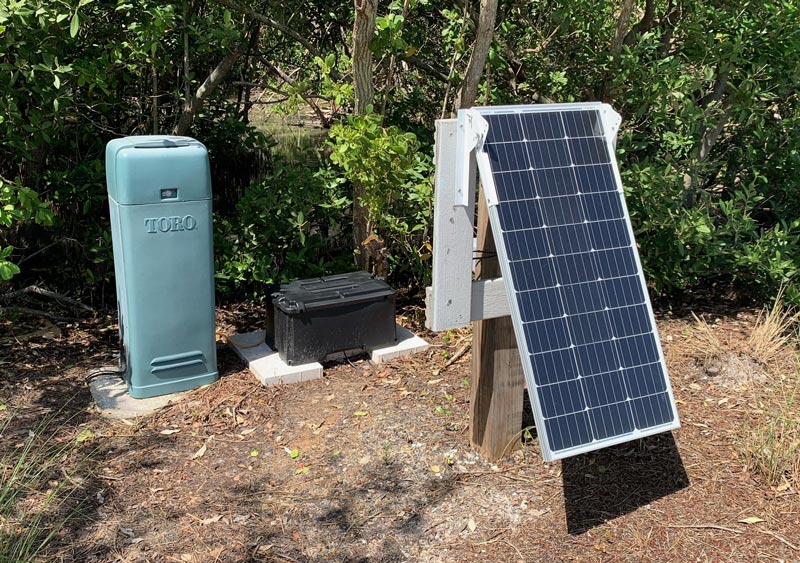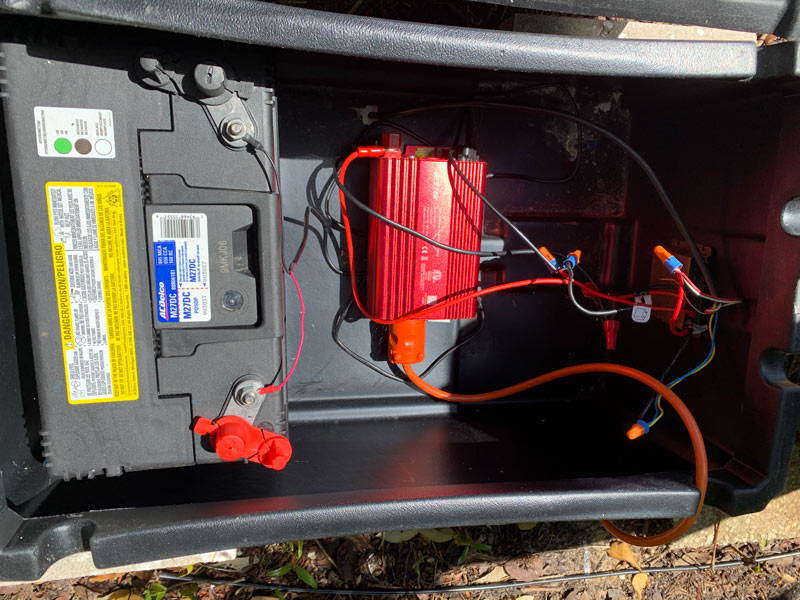
Snagging sunlight: At The Dunes Golf & Tennis Club in Sanibel, Fla., a 100-watt photovoltaic panel powers an irrigation satellite controller that sits alongside a mangrove swamp. Photo by Roy Jones
As solar installations go, Roy Jones’ setup at The Dunes Golf & Tennis Club in Sanibel, Fla., isn’t going to win any “green” awards or even make much of a dent in the course’s electric bills. But it more than nudges the needle in terms of providing a thrifty field fix for a vexing problem.
“It’s a quick and dirty solution for an issue that popped up,” says Jones, superintendent at the 18-hole course on Sanibel Island and a 19-year GCSAA member. “We’re all having to do more with less these days.”
The issue that popped up was a recurring one. Infrastructure at The Dunes was aging, and electrical problems were occasional. One irrigation satellite controller — on the edge of a mangrove swamp, a 1,700-foot run away from the breaker box — had flickered recently and finally went dark. Jones started looking into a long-term fix and found that just the wire and labor to run a new power cable would cost $2,500.
“So, we decided against doing that,” Jones says.
Then a lightbulb went off — a big, thermonuclear-powered one some 93 million miles away. Jones recalled seeing an online post about a golf course superintendent who had powered an irrigation satellite off a power inverter run by his car. What if, Jones wondered, he went with a small-scale solar operation instead?
First, he ran a few tests. He used a fully charged deep-cycle marine battery to power the satellite, and managed to get roughly three days’ worth of power before the battery needed to be recharged. A quick online search revealed a 30-watt solar panel for around $70, which Jones paired with a new deep-cycle battery ($150), inverter ($80) and marine battery box ($90).
That setup, he figured, basking in the plentiful Florida sun, would provide plenty of power to keep the satellite running and the battery topped off, and would even weather the occasional cloudy day.
“We got it all hooked up, and after a few days of testing, we decided that panel was just too small,” Jones says.
Jones found a 100-watt panel online for $90 and swapped it in for the smaller one. The new panel provides more than enough juice. Even with the extra panel, Jones is in it for less than $500, and the electricity is free. Though the power cost savings are negligible, it’s far cheaper than the few grand — plus the inconvenience — the course was facing to have a new cable run.

A look inside the battery box: a 650-CCA marine deep-cycle battery (black), a 300-watt inverter (red) and a charge controller (gold, far right). Photo by Roy Jones
“I guess I could have called an electrician out to find the faults,” Jones says. “But I’ve been at the course 10 years. And I was here back in 1994, ’95 (on a job-placement program while in school), when they did a renovation. I remember where everything went. There are so many splices. And, as I said, it’s along the edge of a mangrove swamp. The area’s always saturated. It didn’t make any sense to try to fix it and have it go bad again in six months.”
Editor’s note: Discover more “turf hacks” — superintendents’ creative, outside-the-box strategies for better, more efficient golf course management.
Though the installation is relatively inconspicuous, golfers have noticed.
“A couple of members asked about it,” Jones says. “Once I tell them what we’re doing, they think that’s pretty cool.”
The Dunes golfers may soon see more solar installations on the course.
“I am actually looking to scale up a bit,” Jones says. “We have a bunch of pond aerators out there putting a strain on (the electrical infrastructure). I think we can run the compressor for the bubblers off solar.”
Jones figures a 200-watt panel and a pair of large marine batteries wired in parallel can get that job done.

The 18-hole golf course at The Dunes Golf & Tennis Club is located within a wildlife preserve on southwest Florida’s Sanibel Island. Photo courtesy of The Dunes Golf & Tennis Club
About the only lingering concern Jones has regarding his little photovoltaic solution is the prospect of vandalism. But ...
“We’re on Sanibel Island,” he says. “If somebody gets a speeding ticket, it’s a big deal on the island. We could have some kids come through and have to deal with some minor vandalism. If we do, we could get some more (substantial) enclosures. But it’s a ways off the green. I don’t think we’ll have to worry about it.”
And now he shouldn’t have to worry about losing power to his wayward satellite.
“Even if it was only a temporary fix, it was only 500 bucks,” Jones says. “The power cost isn’t expensive at all, but it’s an issue that popped up that would have been expensive and inconvenient to fix.”
Andrew Hartsock is GCM’s managing editor.